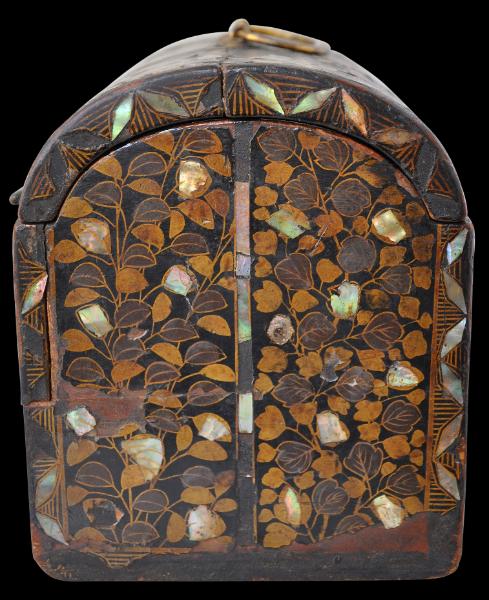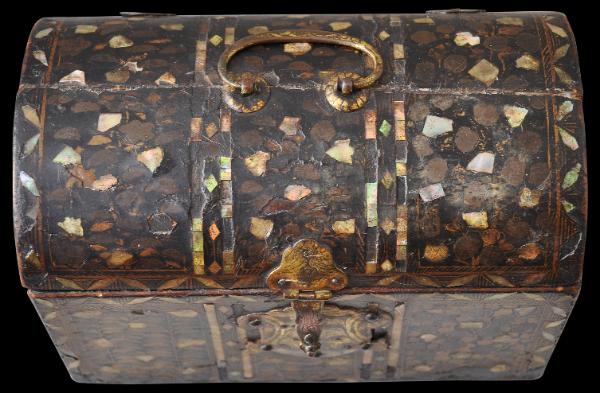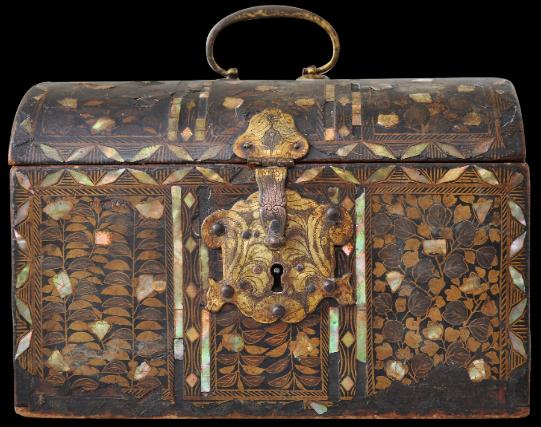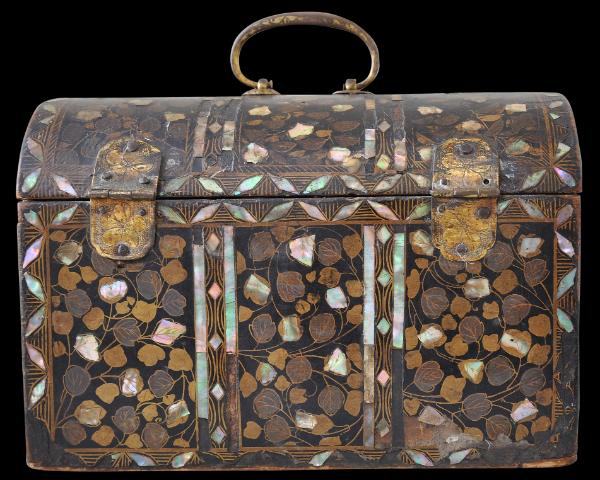Namban Indo-Portuguese Lacquer Chest
Namban Lacquer Coffer made for Portuguese Market
Japan
1575-1615
length: 22cm, height: 15.5cm, width: 13cm
Pope Gregory XIII granted Portugal in 1580 exclusive rights to maritime trade east of the Red Sea to as far as seventeen degrees east of the Moluccas (in today’s eastern Indonesia). Japan thus became one of the new sources for exotic luxury goods that could be imported to Europe for profit. Lacquered chests and other objects inlaid with mother-of-pearl were acquired by the Portuguese from Gujarat in India but the superiority of Japanese mother-of-pearl inlaid lacquer was quickly noticed and so Japan became a new source to feed European demand.
The chests and other objects were lacquered in black (urushi), decorated with gold and silver dust (maki-e) and then inlaid with pearl shell (raden). The items became known in Japan as namban, literally ‘southern barbarian’ but perhaps more appropriately translated as ‘exotic’, and was a reference to the Portuguese who commissioned the goods.
The growth in the Portugal-Japan trade was remarkable for it was only in 1542 or 1543 that the first Europeans visited Japan – three Portuguese sailors landed at Tanegashima after the Chinese junk in which they were sailing apparently was blown off course. The Jesuit missionary Francis Xavier arrived in 1549. The Jesuits made big, early inroads and were particularly successful at propagating Christianity in the south. It is likely that the first Namban lacquewares made for the Portuguese were made for the Jesuits.
Domed coffers were among the earliest items of lacquer exported from Japan to Europe. The form is based on the household chests used for storing textiles in Mediterranean Europe. Smaller versions of the type here were used in Portugal and in colonial Portuguese churches and monasteries to hold relics but also chalices and cruets associated with the Blessed Sacrament. Others were presented by church officials as gifts or were used in barter. The geometric designs on this coffer reflect the Hispanic-Moorish mudejar style popular in Spain and Portugal at the time.
Domed coffers were made as a direct consequence of Portuguese commissions. The domed variety was unknown in Japan until the arrival of the Portuguese. Such coffers were made up until around 1620 when the Portuguese were expelled from Japan and the Dutch United East India Company or Vereenigde Oost-Indische Compagnie (VOC) supplanted the Portuguese. After this date and after an initial period when the VOC did not buy Japanese lacquer, the style of lacquerware exported from Japan changed from having obvious Iberian influence to accord more with Dutch and English tastes.
This example with its domed lid, is decorated with three distinct lacquered and inlaid panels between geometric bands to the front, lid and back, and with two panels each on the sides. The three panels to the front of the coffer are each decorated with differing plants, wheres the three panels at the back are similarly decorated. The interior is of plain black lacquer.
It has gilded, engraved copper hinges, a handle at the top, and a lock and escutcheon. All are original. The escutcheon is engraved with scrolling floral work and has been cut with what appears to be the head of a dog to either side.
A coffer of almost identical size and with similar lacquer designs is in the Museum of Sacred Art of Funchal, Madeira, and illustrated in Clode Sousa et al (2009, p. 230-1).
Other related examples are illustrated in Impey & Jorg (2005) and Flores et al (1998, p. 250). Another is in Harvard University’s Arthur M. Sackler Museum.
Most extant examples of Namban lacquer have been the subject of restoration if they are in perfect condition. Sometimes that restoration has been extensive. This coffer has not be restored in anyway and is in its original condition. Accordingly, there are some age-related losses to the pearl-shell inlay and to the lacquer.
Provenance
from a Spanish collection.
References
Bennett, J., & A. Reigle Newland, The Golden Journey: Japanese Art from Australian Collections, Art Gallery of South Australia, 2009.
Cattaneo, A., et al, Portugal and the World: In the 16th and 17th Centuries, Museu Nacional de Arte Antiga, Lisbon, 2009.
Christie’s London, ‘Important Jesuit Lacquers and Japanese Works of Art from the Age of Western Influence’, November 19, 1985.
Clode Sousa, F., et al, Obras de Referencia dos Museum da Madeira, Instituto dos Museus e da Conservacao, 2009.
Flores, J.M. et al, Os Constructores do Oriente Portugues, Comissao Nacional para as Comemoracoes dos Descobrimentos Portugueses, 1998.
Impey, O., & C. Jorg, Japanese Export Lacquer 1580-1850, Hotei Publishing, 2005.
Museum of Christian Art, Rachol, Goa, 1993.
Inventory no.: 1574
SOLD







